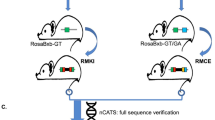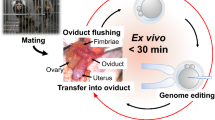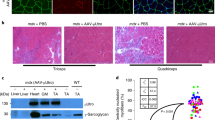Abstract
Nuclear transfer offers a cell-based route for producing precise genetic modifications in a range of animal species. Using sheep, we report reproducible targeted gene deletion at two independent loci in fetal fibro-blasts. Vital regions were deleted from the α(1,3)galactosyl transferase (GGTA1) gene, which may account for the hyperacute rejection of xenografted organs, and from the prion protein (PrP) gene, which is directly associated with spongiform encephalopathies in humans and animals. Reconstructed embryos were prepared using cultures of targeted or nontargeted donor cells. Eight pregnancies were maintained to term and four PrP−/+ lambs were born. Although three of these perished soon after birth, one survived for 12 days. These data show that lambs carrying targeted gene deletions can be generated by nuclear transfer.
This is a preview of subscription content, access via your institution
Access options
Subscribe to this journal
Receive 12 print issues and online access
$209.00 per year
only $17.42 per issue
Buy this article
- Purchase on Springer Link
- Instant access to full article PDF
Prices may be subject to local taxes which are calculated during checkout



Similar content being viewed by others
References
Capecchi, M.R. Altering the genome by homologous recombination. Science 244, 1288–1292 (1989).
Wilmut, I., Schnieke, A.E., McWhir, J., Kind, A.J. & Campbell, K.H.S. Viable offspring derived from fetal and adult mammalian cells Nature 385, 810–813 (1997).
Campbell, K.H.S., McWhir, J., Ritchie, W.A. & Wilmut, I. Sheep cloned by nuclear transfer from a cultured cell line. Nature 380, 64–66 (1996).
Schnieke, A.E. et al. Human factor IX transgenic sheep produced by transfer of nuclei from transfected fetal fibroblasts. Science 278, 2130–2133 (1997).
McCreath, K.J. et al. Production of gene-targeted sheep by nuclear transfer from cultured somatic cells. Nature 405, 1066–1069 (2000).
Galili, U., Shohet, S.B., Kobrin, E., Stults, C.L. & Macher, B.A. Man, apes, and Old World monkeys differ from other mammals in the expression of alpha-galactosyl epitopes on nucleated cells. J. Biol. Chem. 263, 17755–17762 (1988).
Crick, S.J., Sheppard, M.N., Ho, S.Y., Gebstein, L. & Anderson, R.H. Anatomy of the pig heart: comparisons with normal human cardiac structure. J. Anat. 193, 105–119 (1998).
van der Laan, L.J. et al. Infection by porcine endogenous retrovirus after islet xenotransplantation in SCID mice. Nature 407, 90–94 (2000).
Prusiner, S.B. & Scott, M.R. Genetics of prions. Annu. Rev. Genet. 31, 139–175 (1997).
Prusiner, S.B. et al. Ablation of the prion protein (PrP) gene in mice prevents scrapie and facilitates production of anti-PrP antibodies. Proc. Natl. Acad. Sci. USA 90, 10608–10612 (1993).
Weissmann, C. et al. PrP-deficient mice are resistant to scrapie. Ann NY Acad. Sci. 724, 235–240 (1994).
Tearle, R.G. et al. The alpha-1,3-galactosyltransferase knockout mouse. Implications for xenotransplantation. Transplantation 61, 13–19 (1996).
Bueler, H. et al. Mice devoid of PrP are resistant to scrapie. Cell 73, 1339–1347 (1993).
Weissmann, C. & Aguzzi, A. PrP's double causes trouble. Science 286, 914–915 (1999).
Lee, I.Y. et al. Complete genomic sequence and analysis of the prion protein gene region from three mammalian species. Genome Res. 8 1022–1037 (1998).
Joziasse, D.H., Shaper, N.L., Kim, D., Van den Eijnden, D.H. & Shaper, J.H. Murine alpha 1,3-galactosyltransferase. A single gene locus specifies four isoforms of the enzyme by alternative splicing. J. Biol. Chem. 267, 5534–5541 (1992).
Joziasse, D.H., Shaper, J.H., Van den Eijnden, D.H., Van Tunen, A.J. & Shaper, N.L. Bovine alpha 1,3-galactosyltransferase: isolation and characterization of a cDNA clone. Identification of homologous sequences in human genomic DNA. J. Biol. Chem. 264, 14290–14297 (1989).
Sedivy, J. Gene targeting in human cells without isogenic DNA. Science 283, 9a (1999).
DeSousa, P.A. et al. Evaluation of gestational deficiencies in cloned sheep. Theriogenology 53, 214 (2000).
Hill, J.R. et al. Clinical and pathologic features of cloned transgenic calves and fetuses (13 case studies). Theriogenology 51, 1451–1465 (1999).
Clark, A.J., Burl, S., Denning, C. & Dickinson, P. Gene targeting in livestock; a preview. Transgenic Res. 9, 263–275 (2000).
Cibelli, J.B. et al. Cloned transgenic calves produced from nonquiescent fetal fibroblasts. Science 280, 1256–1258 (1998).
Lanza, R.P. et al. Extension of cell life-span and telomere length in animals cloned from senescent somatic cells. Science 288, 665–669 (2000).
Acknowledgements
The authors would like to thank J. Bowering, W. Bosma, P. Johnson, T. Ferrier, D. McGavin, B. Gasparrini, and L. Harkness for technical support, and Jane Lebkowski for reading the manuscript. The Biotechnology and Biological Sciences Research Council and the Geron Corporation provided financial support.
Author information
Authors and Affiliations
Corresponding author
Rights and permissions
About this article
Cite this article
Denning, C., Burl, S., Ainslie, A. et al. Deletion of the α(1,3)galactosyl transferase (GGTA1) gene and the prion protein (PrP) gene in sheep. Nat Biotechnol 19, 559–562 (2001). https://doi.org/10.1038/89313
Received:
Accepted:
Issue Date:
DOI: https://doi.org/10.1038/89313
This article is cited by
-
A review of transgenic animal techniques and their applications
Journal of Genetic Engineering and Biotechnology (2023)
-
Physiological impact of the environment on the welfare of transgenic goats raised in a tropical climate
International Journal of Biometeorology (2021)
-
Proposed U.S. regulation of gene-edited food animals is not fit for purpose
npj Science of Food (2019)
-
Harnessing genomic information for livestock improvement
Nature Reviews Genetics (2019)
-
Use of gene-editing technology to introduce targeted modifications in pigs
Journal of Animal Science and Biotechnology (2018)



